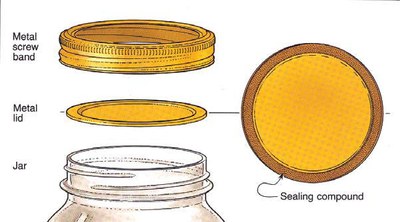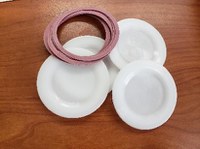Put a Lid On It! Best Practices for Using Closures for Home-based Canning (FN2028, July 2021)
Research-tested canning recipes recommend metal two-piece closures for home-based canning. Two-piece lids are sold to fit regular and wide-mouth glass canning jars and are made up of a flat metal lid and a metal screw band. The lid contains a sealing compound that, when properly used, softens during the canning process and forms an airtight seal as the container cools.
Traditional metal lids are designed to be used only once. When opening the jar, the lid becomes warped. Also, the sealing compound is compromised by use. Unused lids should be stored in a cool, dry location and may be good for up to five years from the date of manufacture. Through time, the sealing compound will degrade and the lid may fail to seal.
CAUTION: Many consumers noticed canning supplies were of inferior quality in 2021. To ensure quality, consider ordering directly from the manufacturer or its representative and not from a third-party vendor.
Best practices for ensuring a safe seal on canning jars include:
Following the manufacturer’s directions for preparing lids. Traditionally, lids were simmered or boiled prior to applying to jars, but this generally is not the case now. Check the directions on the lid package or manufacturer’s website.
- Always wash and rinse lids and bands prior to use. Do not use a dishwasher because this can increase the risk of the metal pieces rusting.
- Leave the proper head space. The unfilled space above the food in a jar and below its lid is referred to as head space. Each home canned food product has a specific recommendation for the depth of the head space. For example, sweet spreads should have a head space of ¼ inch.
- Clean the jar rim (sealing surface) prior to applying the lid. Food residue trapped on the jar rim can cause seal failures.
- Place the metal screw band over the flat lid and apply fingertip tight. In other words, place the screw band on the jar, turn it just until you feel resistance, then turn the band one-quarter turn more. Screw bands that are applied too loosely or too tightly can cause jars to not seal properly.
- After processing, remove jars from the canner and allow to cool 12 to 24 hours undisturbed. Do not retighten screw bands. Once jars are completely cool, check for seal. I t’s a best practice to remove the screw bands for storage. When removed, washed, dried and stored in a dry area, screw bands may be used many times.
Are reusable lids safe for home-based canning?
Recent research using reusable plastic canning lids (such as the Tattler® brand) suggests that reusable lids will seal jars safely when used for home canning. This type of reusable lid also requires a thin rubber gasket. A traditional metal screw band also is needed during canning.
What do I need to know if I use a reusable canning jar lid?
- Follow the manufacturer’s instructions for use explicitly.
- Manufacturer’s instruction may instruct the user to tighten the metal band immediately upon removal from the canner. If instructed, you should do so. Tightening the screw band ensures that the gasket forms a seal. The metal screw band is removed once the container is cooled and a seal has formed.
See www.ag.ndsu.edu/food for more information.
Written by Julie Garden-Robinson, Ph.D., R.D., L.R.D., food and nutrition specialist, and members of the North Central Food Safety Extension Network (NCFSEN)


Source: G. Sivanandam. Evaluation and Comparison of the Sealing Performance of Three Major Types of Jar Lids Available for Home Canning. Thesis Project – University of Georgia. https://tinyurl.com/pj7ywjat
Information in this publication is provided purely for educational purposes. No responsibility is assumed for any problems associated with the use of products or services mentioned. No endorsement of products or companies is intended, nor is criticism of unnamed products or companies implied.



